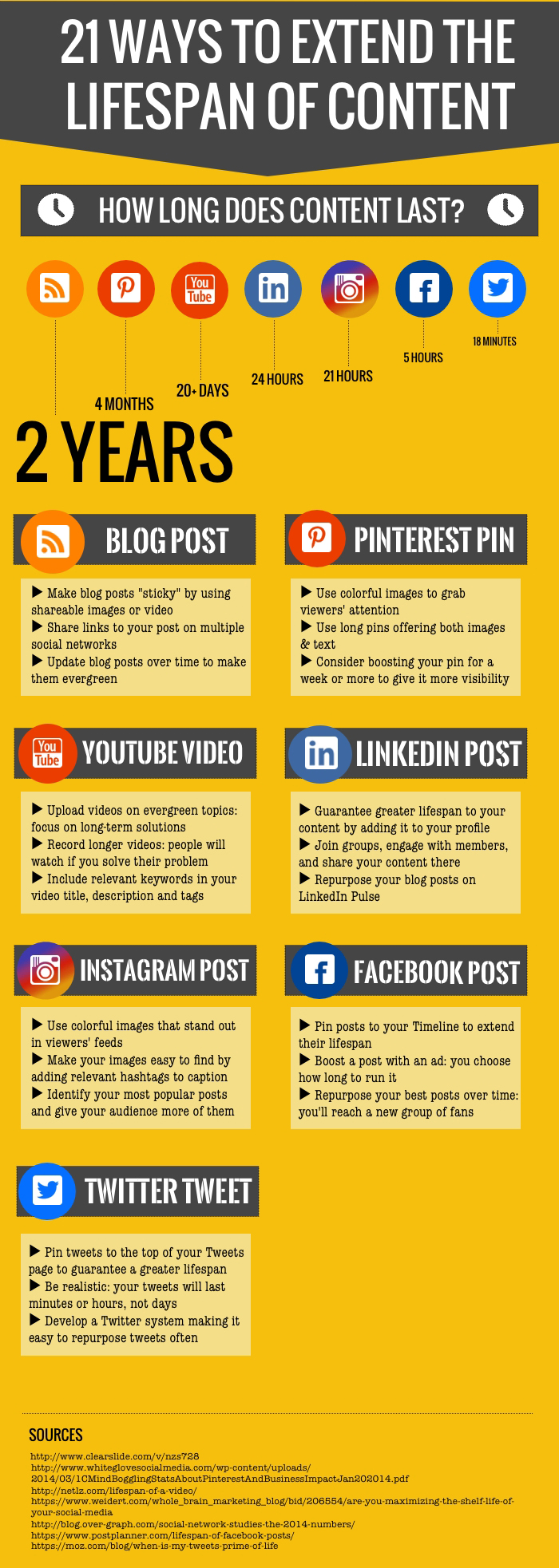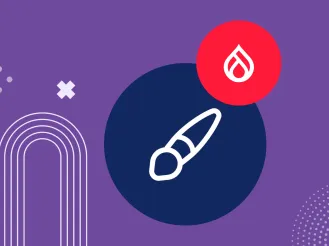Any individual’s greatest resource is their time. And for a business, investing their employee’s time wisely in efforts that yield the greatest results is essential to maximizing their returns. Applying this principle to content marketing means creating content that can return continuous results -- sometimes referred to as
evergreen content. The most effective way to achieve this is to produce compelling content that delivers timeless value to a wide range of people; but while this is certainly a goal to aspire to, these pieces are few and far between. They’re like the unicorns of content marketing. For the majority of the content we produce, it helps to know what the typical lifespan of it is across different platforms and what we can do to maximize that.
 Image credit.
Image credit. While Facebook and Twitter are great resources for sharing your content, the reality is that they’re like live broadcasts -- old content is continuously giving way to new in people’s feeds.
TrackMaven explains this in more detail, based on data from
Bitly: the typical half-life of a link on Twitter is just 2.8 hours, which means that half of its total engagement will occur in less than three hours. Similarly, the half-life for a link on Facebook is 7.4 hours. What this shows is that the content you likely spent hours creating will receive most of its total engagement in less than one business day. So what steps can content creators take to extend the life of their content? Here are three.
Repurposing
Outbrain explains content repurposing as “...the changing of a work’s format and/or intended audience. Changing a work’s format, or medium, could be like reworking one of your Facebook posts in a Twitter post; changing the intended audience could be changing the words in an article for people in marketing to match the vocabulary used in a different field. Repurposing content is also taking a previously used idea or article and using it to support or be a part of a new idea or article.” Content can be repurposed in many forms. For example, a content-heavy white paper can be broken up into smaller more digestible assets like slideshows, infographics, and blog posts. And then these assets can be cross-promoted across multiple social channels, or included in email newsletters. Alternatively, you can publish a high-level summary of a particular topic and then serialize it by publishing follow-up posts that explain different points in greater detail. This helps to affirm your status as a thought leader on the subject, as well as giving you an opportunity to link back to your previous posts to continue to drive traffic to them.
Share, Share, and Share Again
No matter what the goal of your content -- new followers, data capture, generating leads, or converting leads to sales -- the more your content is read, the more likely you are to achieve that goal. But as your metrics probably already show, simply sharing it on social media when you publish it doesn’t necessarily lead to engagement. That’s because, as we explained above, social media -- especially Facebook and Twitter -- are closer to broadcast media in that newer content is continually replacing the old. So to increase the likelihood that your content will be seen, you can borrow a technique from television -- that is, airing repeats, or re-sharing your content. Even if each subsequent share only results in half of the engagement as the share before it, those are still views that your content wouldn’t have received otherwise. This technique requires some basic thoughtfulness, though. No single piece of content should be shared more than three times in a row -- doing so will result in your audience feeling spammed. Instead, reach back into your older content, especially if other trending topics have made in relevant again, and re-share using different copy in your tweet or post.
Repackage Underperforming Content
Did you publish what you thought was a killer post, only to see it quickly fade away with a fraction of the views that you expected? It’s possible that you just didn’t sell it well enough. Try to re-publish the same content, but with different titles, headings, subheadings, and copy to promote it in your tweets and posts. One word of caution about this strategy, though: what you promote matters much more than how you promote it, so if your content isn’t up to your usual standards then no amount of reselling it will make up for its lack of value. In this case, it would be a better use of your time to re-write the content using the same ideas or move on to a new idea altogether. Bitly echoed this when they said that “in general, the half-life of a Bitly link is about three hours, unless you publish your links on YouTube, where you can expect about seven hours worth of attention. Many links last a lot less than two hours; other more sticky links last longer than 11 hours over all the referrers. This leads us to believe that the lifespan of your link is connected more to what content it points to than on where you post it: on the social web it’s all about what you share, not where you share it!”
Wrapping Up
Do you know which of your content has performed the best over the last year or two? If so, what have you done to re-promote it to help re-capture some of that momentum? Repurposing, resharing, and repackaging your best content can help to extend its life from a one-time success to a long life of added value.
 Image credit. While Facebook and Twitter are great resources for sharing your content, the reality is that they’re like live broadcasts -- old content is continuously giving way to new in people’s feeds. TrackMaven explains this in more detail, based on data from Bitly: the typical half-life of a link on Twitter is just 2.8 hours, which means that half of its total engagement will occur in less than three hours. Similarly, the half-life for a link on Facebook is 7.4 hours. What this shows is that the content you likely spent hours creating will receive most of its total engagement in less than one business day. So what steps can content creators take to extend the life of their content? Here are three.
Image credit. While Facebook and Twitter are great resources for sharing your content, the reality is that they’re like live broadcasts -- old content is continuously giving way to new in people’s feeds. TrackMaven explains this in more detail, based on data from Bitly: the typical half-life of a link on Twitter is just 2.8 hours, which means that half of its total engagement will occur in less than three hours. Similarly, the half-life for a link on Facebook is 7.4 hours. What this shows is that the content you likely spent hours creating will receive most of its total engagement in less than one business day. So what steps can content creators take to extend the life of their content? Here are three.  Image credit. While Facebook and Twitter are great resources for sharing your content, the reality is that they’re like live broadcasts -- old content is continuously giving way to new in people’s feeds. TrackMaven explains this in more detail, based on data from Bitly: the typical half-life of a link on Twitter is just 2.8 hours, which means that half of its total engagement will occur in less than three hours. Similarly, the half-life for a link on Facebook is 7.4 hours. What this shows is that the content you likely spent hours creating will receive most of its total engagement in less than one business day. So what steps can content creators take to extend the life of their content? Here are three.
Image credit. While Facebook and Twitter are great resources for sharing your content, the reality is that they’re like live broadcasts -- old content is continuously giving way to new in people’s feeds. TrackMaven explains this in more detail, based on data from Bitly: the typical half-life of a link on Twitter is just 2.8 hours, which means that half of its total engagement will occur in less than three hours. Similarly, the half-life for a link on Facebook is 7.4 hours. What this shows is that the content you likely spent hours creating will receive most of its total engagement in less than one business day. So what steps can content creators take to extend the life of their content? Here are three. 






